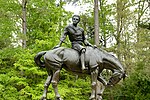Waxhaw Presbyterian Church Cemetery
1757 establishments in the Thirteen ColoniesCemeteries on the National Register of Historic Places in South CarolinaChurches in Lancaster County, South CarolinaNational Register of Historic Places in Lancaster County, South CarolinaPresbyterian cemeteries in the United States ... and 2 more
Presbyterian churches in South CarolinaProtestant Reformed cemeteries

Waxhaw Presbyterian Church Cemetery, also known as Old Waxhaw Cemetery, is a historic Presbyterian church cemetery located near Lancaster, Lancaster County, South Carolina. It was founded in 1757 and is a visual reminder of the pioneer settlement of Waxhaw. It includes noteworthy examples of 18th and 19th century tombstones.It was added to the National Register of Historic Places in 1975.
Excerpt from the Wikipedia article Waxhaw Presbyterian Church Cemetery (License: CC BY-SA 3.0, Authors, Images).Waxhaw Presbyterian Church Cemetery
Industrial Park Road,
Geographical coordinates (GPS) Address Nearby Places Show on map
Geographical coordinates (GPS)
| Latitude | Longitude |
|---|---|
| N 34.788888888889 ° | E -80.847777777778 ° |
Address
Industrial Park Road (Industrial Park Drive)
Industrial Park Road
South Carolina, United States
Open on Google Maps






